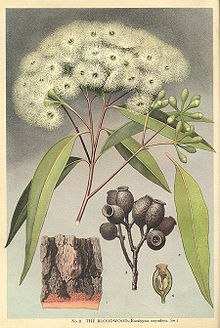Corymbia gummifera
| Red bloodwood | |
|---|---|

| |
| Scientific classification | |
| Kingdom: | Plantae |
| Clade: | Tracheophytes |
| Clade: | Angiosperms |
| Clade: | Eudicots |
| Clade: | Rosids |
| Order: | Myrtales |
| Family: | Myrtaceae |
| Genus: | Corymbia |
| Species: | C. gummifera
|
| Binomial name | |
| Corymbia gummifera | |
| Synonyms[1] | |
|
Synonyms
| |



Corymbia gummifera, commonly known as red bloodwood,[2] is a species of tree, rarely a mallee, that is endemic to eastern Australia. It has rough, tessellated bark on the trunk and branches, lance-shaped adult leaves, flower buds in groups of seven, creamy white flowers and urn-shaped fruit.
Description
Corymbia gummifera is a tree that typically grows to a height of 20–35 m (66–115 ft), rarely a mallee, and forms a
Taxonomy
The red bloodwood was first formally described in 1788 by Joseph Gaertner who gave it the name Metrosideros gummifera and published the description in his book De Fructibus et Seminibus Plantarum. (The name is often given as Metrosideros gummifera Sol. ex Gaertn., but Gaertner did not ascribe the name to Solander.)[6][7][8]
The name Eucalyptus corymbosa, published by James Edward Smith in his 1795 A Specimen of the Botany of New Holland,[9] is regarded as a synonym by the Australian Plant Census.[1] Eucalyptus corymbosus, published in 1797 by Cavanilles in his book Icones et Descriptiones Plantarum is an orthographical variant.[10][11] Eucalyptus oppositifolia, published in 1804 by Desfontaines is a nomen nudum because no description was provided.[12][13] Eucalyptus purpurascens var. petiolaris, published in 1828 by de Candolle is regarded as a synonym.[14] Eucalyptus longifolia, published in 1920 by Joseph Maiden is an invalid name because it had already been used for a different species.[15][16]
In 1995 Ken Hill and Lawrie Johnson changed the name to Corymbia gummifera.[6][17]
Distribution and habitat
Corymbia gummifera mainly occurs on flats and low hills along the coast between the extreme eastern corner of Victoria and south-eastern Queensland. It grows best on moist, rich, loamy soil, but is also commonly found on poorer sandy soils.[2]
Uses
The heartwood of C. gummifera is very strong and durable, but has extensive gum lines. It is used for rough construction purposes, such as poles, sleepers, fencing and mining timbers.[2]
Corymbia gummifera may be used as a rootstock, onto which the ornamental C. ficifolia is grafted.[18]
References
- ^ a b c "Corymbia gummifera". Australian Plant Census. Retrieved 13 February 2020.
- ^ ISBN 0643069690.
- ISBN 1-876473-03-7.
- ^ "Corymbia gummifera". Euclid: Centre for Australian National biodiversity Research. Retrieved 6 June 2020.
- ^ Chippendale, George M. "Eucalyptus gummifera". Australian Biological Resources Study, Department of Agriculture, Water and the Environment, Canberra. Retrieved 13 February 2020.
- ^ .
- ^ "Metrosideros gummifera". APNI. Retrieved 13 February 2020.
- ^ Gaertner, Joseph (1788). De Fructibus et Seminibus Plantarum. Stuttgart: Sumtibus Auctoris, Typis Academiae Carolinae. pp. 170–171. Retrieved 13 February 2020.
- ^ "Eucalyptus corymbosa". APNI. Retrieved 13 February 2020.
- ^ "Eucalyptus corymbosus". APNI. Retrieved 13 February 2020.
- ^ Cavanilles, Antonio J. "Icones et Descriptiones Plantarum". Retrieved 13 February 2020.
- ^ "Eucalyptus oppositifolia". APNI. Retrieved 13 February 2020.
- ^ Desfontaines, René Louiche (1804). Tableau de l'École de botanique du Muséum d'histoire naturelle. Paris. p. 222. Retrieved 13 February 2020.
- ^ "Eucalyptus purpurascens var. petiolaris". APNI. Retrieved 13 February 2020.
- ^ "Eucalyptus longifolia". APNI. Retrieved 13 February 2020.
- ^ Maiden, Joseph (1920). A Critical Revision of the Genus Eucalyptus. Sydney: New South Wales Government Printer. p. 245. Retrieved 13 February 2020.
- ^ "Corymbia gummifera". APNI. Retrieved 13 February 2020.
- ^ "Corymbia Cultivars". Australian Native Plants Society (Australia). Retrieved 5 February 2021.
